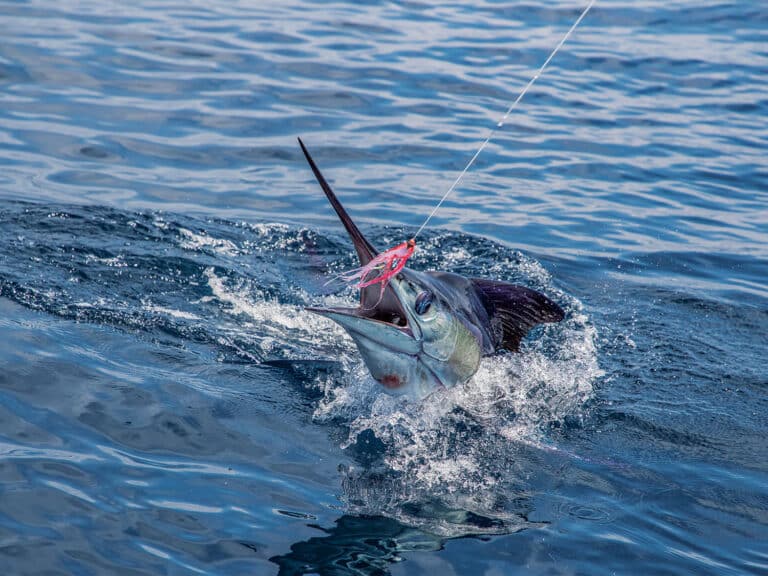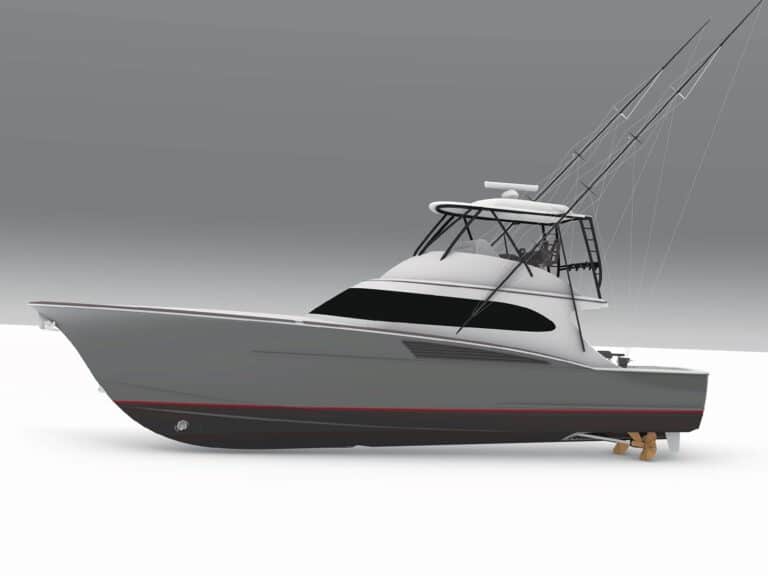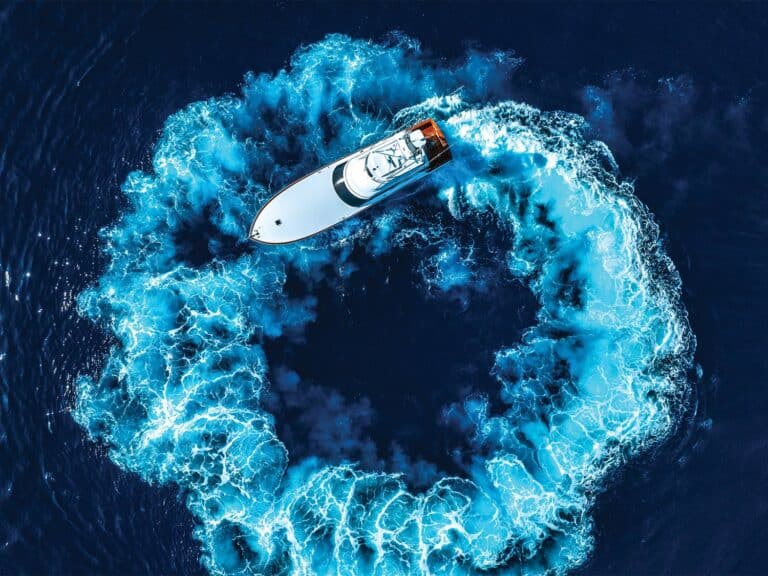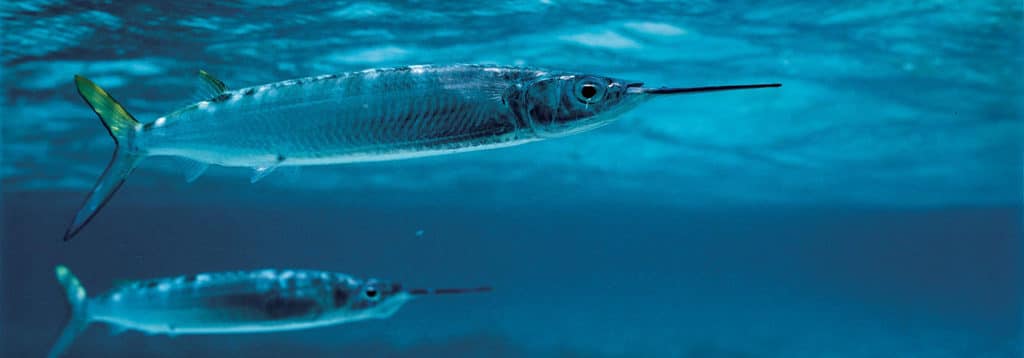
Ballyhoo: the perfect bait. Just about everything that swims in the ocean eats ballyhoo, and they are plentiful, especially throughout the Florida Keys. Sold worldwide on the commercial market, the majority of the stock is caught from north of Key Largo down to Sombrero Key, with strict boundaries and bag limits in place to control overfishing of this high-demand commodity. And since the Florida Keys is regarded as a grade-A hot spot for catching Atlantic sailfish, it’s no wonder the sails hang around.
Unlike dead-bait trolling, Florida Keys captains fish their ballyhoo live, and have been doing so for nearly 50 years. In early fall, the bait begins migrating from Hawk Channel — extending from Biscayne National Park to Key West, between the shoreline and the shallow reef line — to congregate on the protected nearshore reefs just west of the edge. With populations in the millions, hundreds of individual ballyhoo schools are plentiful enough to catch your own, if you know where to look. Responding to tide and wind, schools are located, caught on hair hooks, and kept alive for the day’s fishing. And when the fishing is good, it’s damned good, so you wouldn’t dare leave the patch reef until you’ve caught at least five dozen by hand and cast-netted dozens more for chumming.
A Unique Fishery
In late fall and early winter, sailfish are in the shallows hunting ballyhoo, along with several other species of pelagics, reef fish and birds, as they intercept the bait either moving around the patch reefs or in and out from the edge. It’s a common sight to see mahi, bonito, tuna, and even grouper and snapper chasing these showering ballyhoo; it’s here, in a National Geographic display of hunter versus hunted where the seasoned Keys captains can really rack up the numbers.
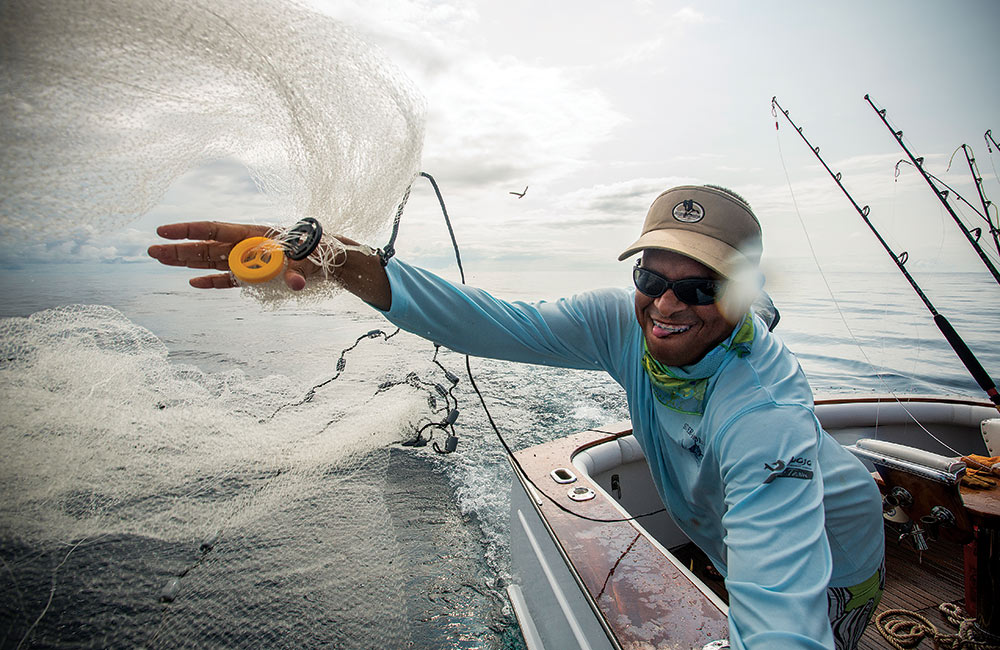
According to Capt. Chris White of the 64-foot Spencer, Sweet Release, it’s the sharp reef line that sets the Florida Keys apart from the rest of the South Florida sailfish fishery. He says that the structure, the amount of schooling bait and the sharp edge creates a trifecta, which gives the fish a definitive area to congregate. The plateaus found in other areas produce bites from traveling sailfish rather than ones that are actively hunting and feeding. While both fisheries produce numbers in the double digits on a good day, sailfishing in the Florida Keys employs several methods that are unique to the region.
The tactics used by captains in these tower-topped sport-fishers range from sight-fishing — where anglers cast to individual sails spotted in the sandy shallows — to running-and-gunning the sailfish wolf packs that round up entire schools of ballyhoo. I do both types of fishing myself, and I can tell you it’s not easy. It takes years of experience to recognize the signs of a feeding event about to happen and to spot traveling sails patrolling the sandy channels that run between the shallow reef and the reef edge, from the 60-foot depths to as shallow as 15 feet of water. Whether it’s sight-casting or fishing straight out of the riggers on the edge, Keys ballyhoo live-baiting requires much more skill than you might think.
The History
The original charter captains in the Keys mostly spent their days trolling for sails with dead ballyhoo, and occasionally trying their luck with live pinfish, mullet, blue runners or even small yellowtail snapper. It wasn’t until 1970 that Capt. Allan Starr and his then-mate Capt. Alex Adler began to experiment using live ballyhoo on spinning tackle. “Starr was the true innovator of live-baiting as we know it today,” says White. “He perfected it, and in North Key Largo, we ran with it. The majority of the techniques he figured out, we still use today.” Indeed, a true innovator.
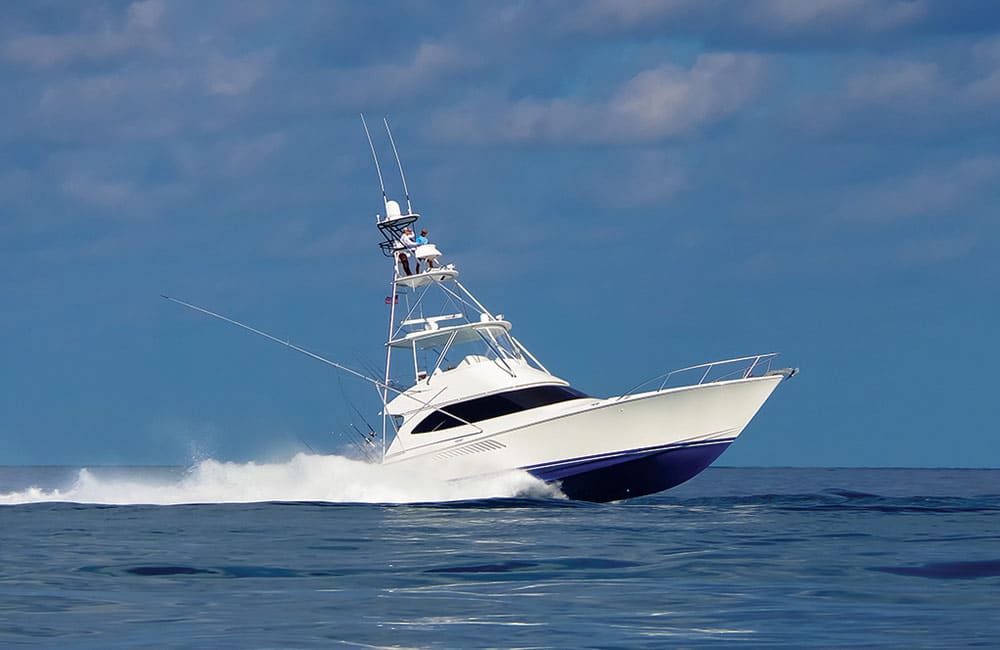
“There are no fences in the ocean,” says Starr. “I noticed the same body of fish would move southwest from Conch Reef to Alligator Light in just one afternoon.” After seeing 80 sailfish actively feeding in one day, Starr knew his charter business was going to flourish — if he could just figure it out. His 37-foot Merritt, Hooked, was the fastest boat in the Keys fleet and the only one with a tuna tower, so Starr set out on a venture that would revolutionize sailfishing and put these tiny rocks on the worldwide sport-fishing map.
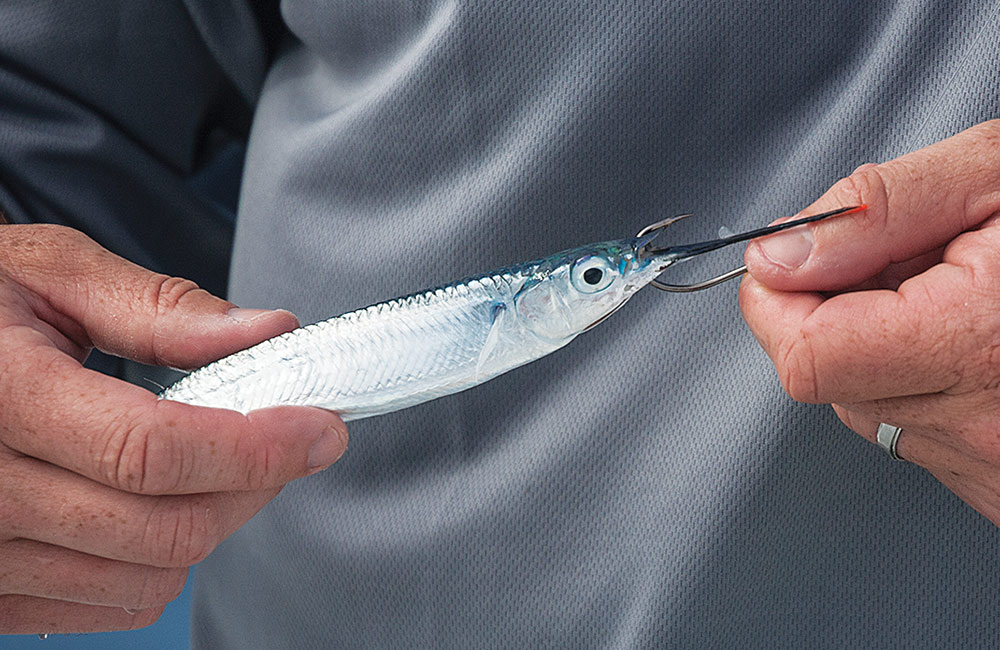
Watching sails push bait up and down the reef, day after day, it was the late Don Gurgiolo who originally started trying to catch ballyhoo and keep them alive for bait. “After a while, I think he got frustrated with it,” says Starr, “so I picked up where he left off and started experimenting with things like how to successfully catch them and then how to keep them alive.” Using a hair hook, a small float and a tiny piece of shrimp was — and still is — the best method, but the optimal conditions for catching bait continued to baffle him. “Sometimes it was easy, but when the tide was against the wind, the school would thin out and get in front of the boat, with no way for us to get to them,” says Starr.
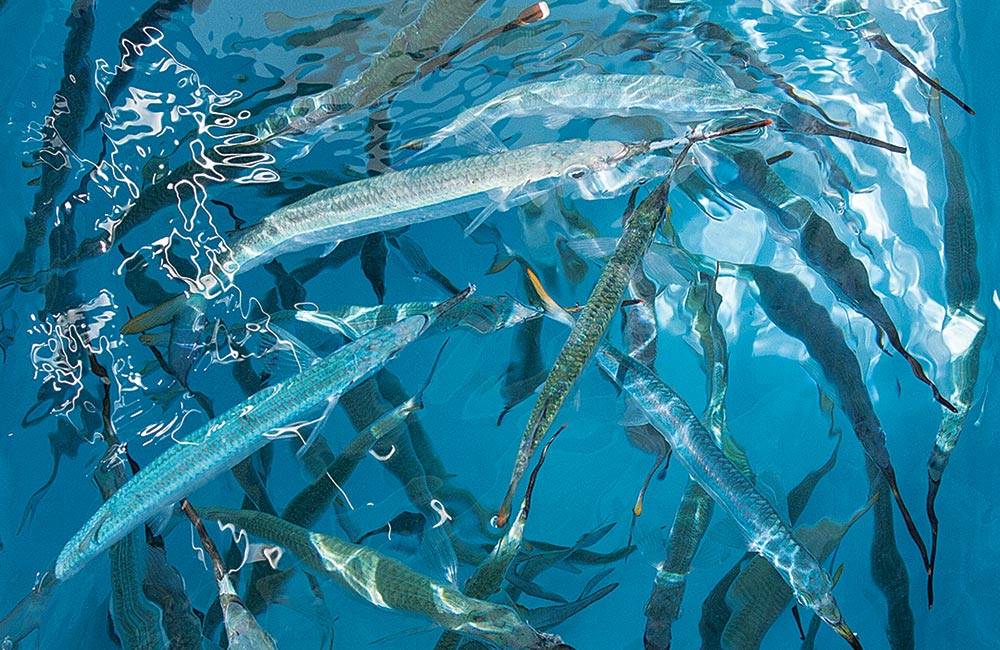
And because the tide waits for no man — or charter, for that matter — Starr had to adjust his approach. When the tide and the wind were opposing one another, getting the ballyhoo out from in front of the anchored boat was vital. “We put out a kite with a chum bag attached to it so the bait could swim to the chum slick,” he says. Once the bait came within netting distance, a few throws with the cast net filled the livewells.
Keeping the bait alive was the next battle. “There needed to be a textbook balance between water turnover and aeration,” Starr explains. “We started out with a hose filling the fish box and soon realized the flow was too strong, so we went to aeration, which wasn’t enough.” Starr then took his thinking to mix the two and came up with what can best be described as a modern-day livewell standpipe. And it worked.
Running the Showers
The term “bait shower” comes from just what you might imagine: A school of hundreds of ballyhoo swimming for their lives as the sailfish corral them to the point that the ballyhoo begin jumping from the water to escape. This action creates a visual effect resembling a rain shower or spray hitting the water’s surface. Because ballyhoo seem to lack a swim-down gene, the sailfish rush the baitfish skyward, usually pushing them inshore and in one direction — a telltale sign that a shower has sails under it. The bigger the shower, the more sails are likely present, as opposed to just a sprinkle, which could be only one or two. Understanding the visual signs is vital, and it comes from experience.
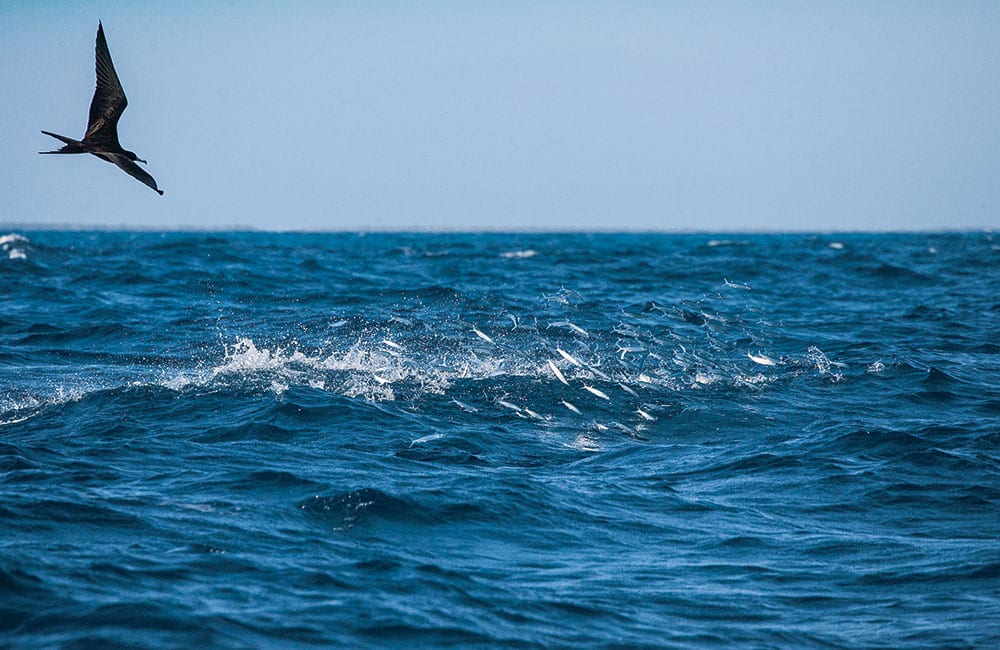
When looking for signs, the frigate birds begin to spool up, moving ever closer to the water’s surface in anticipation of an event about to occur. High birds in a group watch the school of ballyhoo, waiting for an opportunity to swoop down for their meal as soon as the sails home in on the same school. “The birds can tell you a great deal about the shower,” says White. “You have to read the birds: Ninety percent of the time, they will tell you whether it’s mackerel or sailfish on the bait.” The amount of time the bird spends on the school offers the best clue. “The longer the bird stays, the more likely it is that sails are pushing the bait — they simply push longer than anything else,” White says.
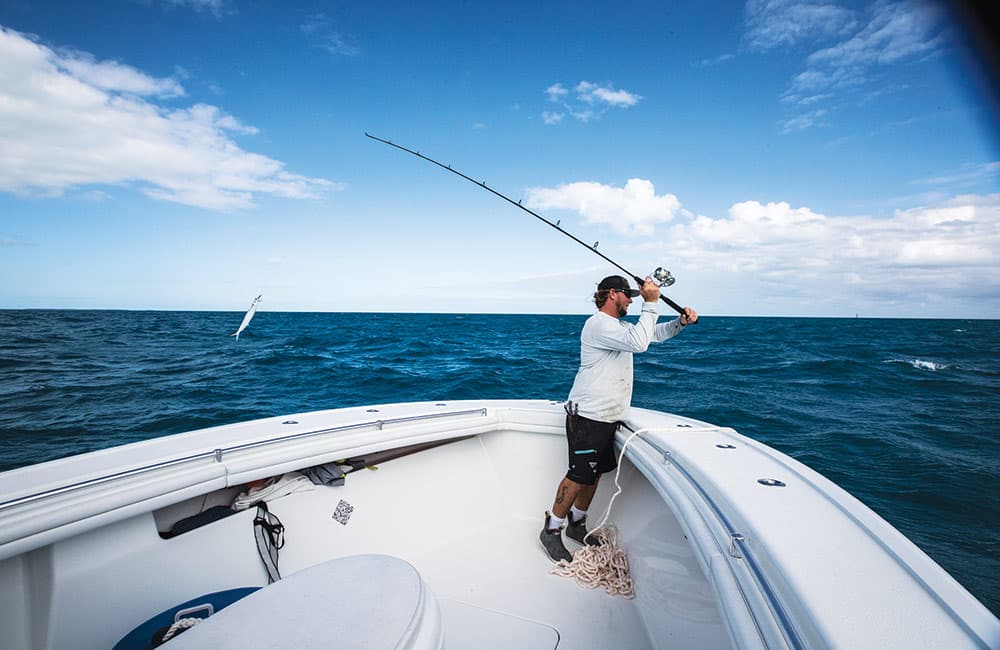
When the birds stay down close to the surface, it’s game on: The captain needs to position the boat so the angler can make an effective cast — preferably downwind — landing the live bait in front of the showering ballyhoo. Since sailfish seem to have no concern for the boat (most of us have seen them eat a live bait nearly out of the exhaust), getting the boat where you can see the fish and then land a solid cast is critical for a hookup. Run over them, and the sailfish swims under you and back offshore. Miss the target, and the fish never sees the bait.
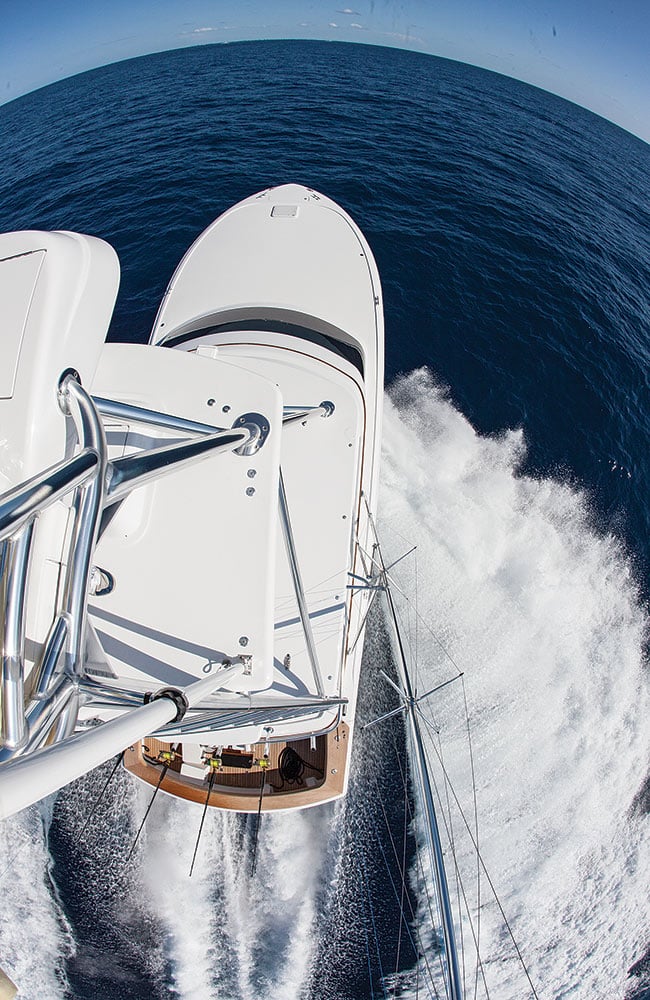
White insists he lives by the three C’s of shower fishing when it comes to the best conditions: namely clear, clean and calm water. Luckily in the Keys, there seems to be plenty of that in the shallows, even in the dead of winter. Starr says that just charging into a shower won’t get you bit: He believes you need a fast boat with a tower, expert casting and good anglers who can think on their feet in sometimes-stressful situations.
From the tower to the cockpit, flawless communication is key. The luxury of having a mate in the tower will also allow the crew to multitask this high-energy, fast-moving game: One keeps an eye on the sailfish while the captain watches for other boats and positions the vessel in the best position for a cast into the shower. Since you should always approach the bait shower from the side, or even from behind, having the fastest boat in the fleet will put you at an advantage. Once in position, a simple call of time for direction and, if needed, distance, from the tower, and one or two baits fire out from the cockpit: “10 o’clock, going to 11, 30 feet out … he ate you!”
Sight-Fishing in the Sand
Spotting a traveling sail heading from north to south is tedious and time consuming. Most of the time, anglers must stand ready for what might seem like hours as the captain, and usually a mate, slowly meander around while the sun is high. The pair are on the lookout for the snakelike silhouette of a sailfish against the white-sand bottom. Once a fish is spotted, the captain moves in front of or alongside the fish and the casting begins.
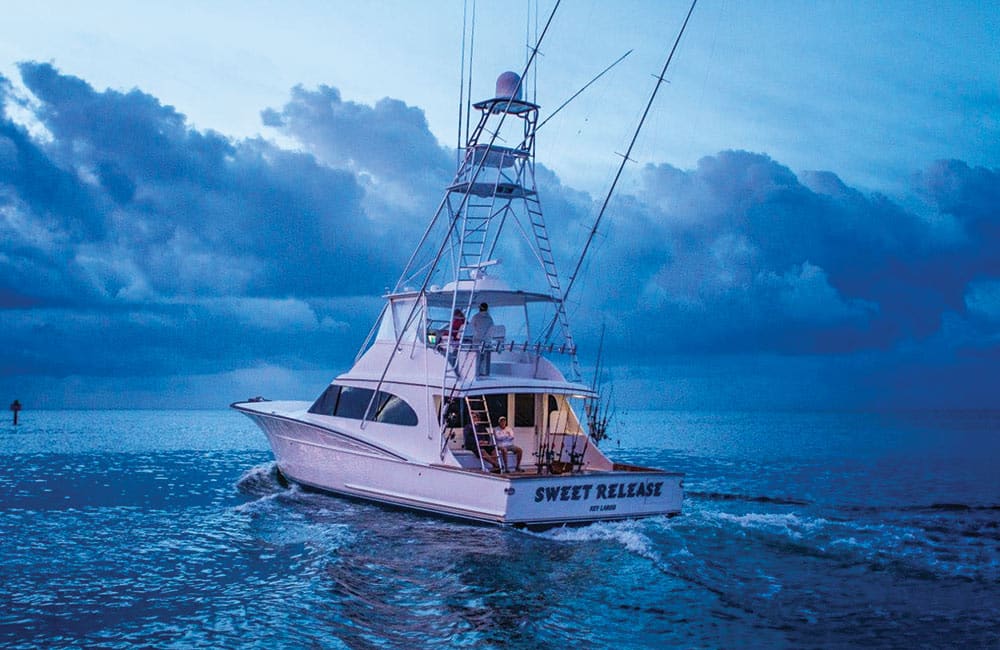
Credited as one of the best in the Keys, Capt. Alex Adler of the Islamorada charter boat Kalex says when the fishing offshore is slow, he won’t wait for the fish to come to him; he goes to find them — in the sand. The constantly moving sails use cuts in the reefs to migrate up and down the edge, says Adler, utilizing their lateral line to feel the bait’s location as conditions change throughout the day. Because ballyhoo respond to wind, tide, water temperature and clarity, the sailfish respond as well: Find the bait and you’ll find the sails.
According to Adler, you can find these fish by looking from any direction, as long as the sun is not directly in your face. Using the light to his advantage, at a speed of 10 to 12 knots, Adler scans the sandy bottom from the tuna tower, what he calls his moving tree stand. Covering ground for miles, never leaving the 30- to 60-foot range, “You must always have your head on a swivel,” he says, “always keeping in mind that when you do see one, you have to present your bait effectively, by either backing up to the fish or swinging around.”
Alder believes having the foresight to know where the fish is heading helps if you have to wheel around on the fish after it is spotted. Having clear water and a sunny sky is optimal for this type of sight-fishing. It is a great way to get a few bites when the fishing is slow elsewhere.
Fishing on the Edge
Because bait in the Florida Keys tends to pile up on the reef edge, so do the sailfish, in depths ranging anywhere from 60 to 200 feet on a typical winter day. However, presenting a live ballyhoo to a sailfish from an almost-motionless boat in a 20-knot wind is a skill that has been passed down through the ranks of local captains with thousands of hours of experience sitting on that same edge, in the same depths. To merely sit in 130 feet of water hoping that a pack of hungry sailfish will magically appear under your stagnant live-bait spread is sure to result in days of flagless riggers.
Good current, regardless of water quality, is the main ingredient to fishing the edge in the Florida Keys, White insists. “I’ve seen more fish in green water than I ever have in blue.” So there is a method to this madness, and with migrating sails constantly passing by, or even at times just meandering around the same area, you need to be able to create and then capitalize on your opportunities. Just seeing fish is not necessarily an opportunity. Getting bites is the goal, and catching them is the result.
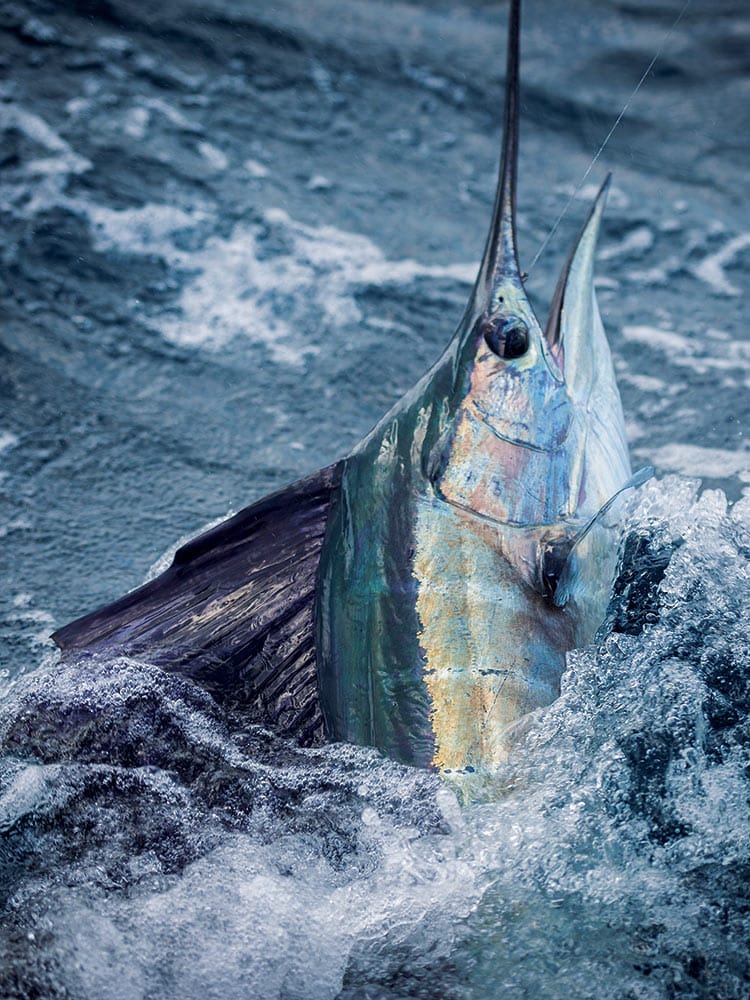
Fresh baits are your best chance to get bites out of finicky fish, says White, another one of the most productive live ballyhoo fishermen in the Keys today. “If you see a fish in your spread and that ballyhoo doesn’t get up or jump, change it out. It’s the buffet analogy,” White says. “If you see the chef coming out of the kitchen with a fresh tray of steaming sirloins, that’s what you want, not the ones that have been sitting there for three hours. Fish aren’t any different: If they are going to work for a meal, it needs to be worth the effort. Otherwise, it won’t stop. It just keeps swimming … right past you and into the next guy’s spread.”
Additionally, White says the ballyhoo can see a sailfish, and vice versa, from much farther away than you might think. “When you skip the right short ballyhoo out of the water to get the attention of a tailing sailfish on that side of the spread, and the bait on the left short starts jumping, it’s not because you skipped the one on the right side; it’s because the ballyhoo saw the sailfish turn — on the other side of the spread.” Taking note of how your baits are behaving will clue you in to what is going on under the surface.
Thanks to innovative captains like Allan Starr, Alex Adler and others, Keys sailfishing has seen an evolution in techniques, from catching bait to presenting them effectively in front of feeding fish. And there is little doubt that those tactics will continue to evolve as we continue to play out an ongoing game of chase between the sailfish and the anglers and captains who love them.
Baiting Up, Keys Style
Catching live ballyhoo in the Keys isn’t difficult, but depending on the conditions, it can present a challenge. You’ll need a lightweight, 6- to 8-pound-test spinning outfit with a long rod for casting distance, plus weighted floats, Nos. 10 and 12 long-shank hair hooks, a small bait dehooker, frozen chum blocks, and fresh shrimp cut into tiny pieces. Start by approaching a likely looking patch reef at idle, and deploy the chum bag.
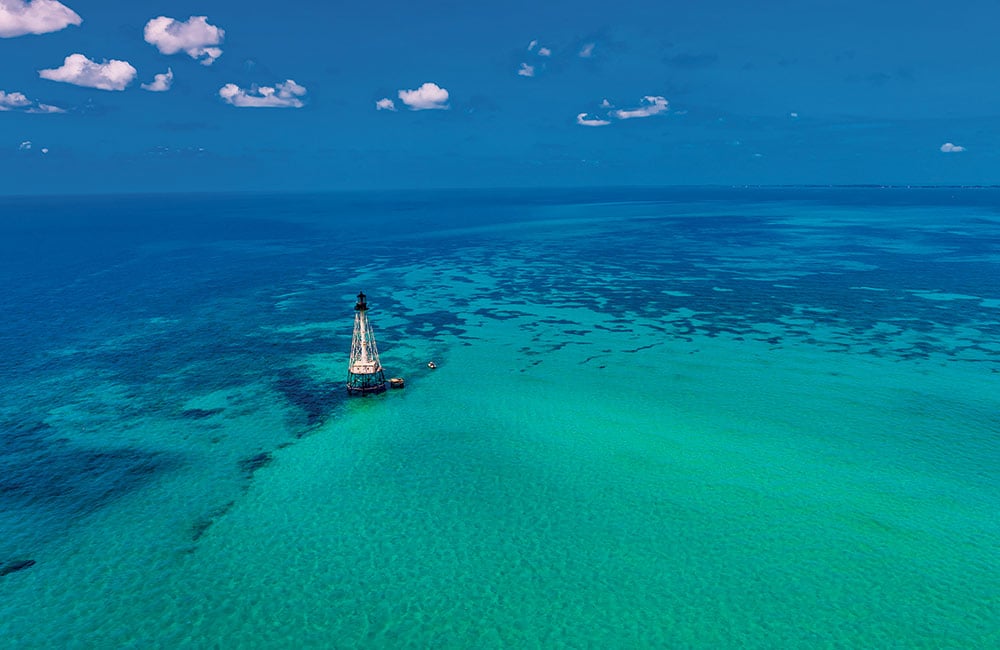
Move around the reef and anchor on the up-current side so the chum slick flows across the reef. When ballyhoo appear in the chum slick, they will look like rain droplets on the surface. Once hooked, swing the bait directly over the livewell and use a dehooker to remove it from the hook, and don’t overcrowd the livewell. Once you have caught enough by hand, make a few throws with a large cast net for additional chum baits.
About the Author
Capt. Jen Copeland is a 20-year marine-industry professional who enjoys telling a good story, especially about big-game fishing. She currently runs the Viking 50 Three C’s in North Key Largo, Florida.
Editor’s Note: Hurricane Irma’s Impact
As this issue was going to print, Hurricane Irma made landfall at Cudjoe Key as an incredibly destructive Category 4 storm, one of the worst to hit the Florida Keys in recent memory. A number of the region’s top charter boats were sunk, and the devastation was significant throughout the islands. The people of the Keys will rebuild, but it will take time — and money.
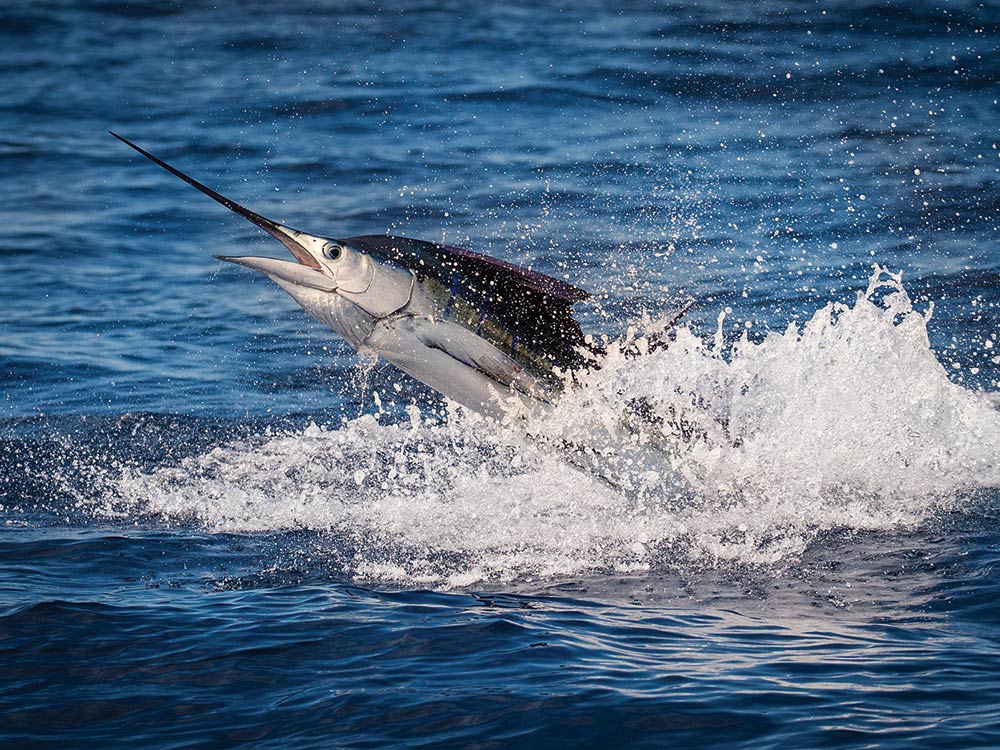
So what can we do to help? Go fishing. Call ahead to make sure that boats and lodging are available, but the fastest way to aid in the recovery is to support the local economies, from Key Largo to Key West. Charter a boat, stay in a hotel, and eat dinner in a restaurant. Maybe tip the crew a little extra, knowing they want to get back to work just as badly as you want to head offshore.
Together, we can get the Florida Keys up and fishing again as quickly as possible.




